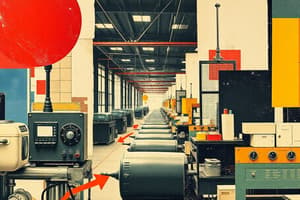Podcast
Questions and Answers
What is the primary focus of manufacturing processes?
What is the primary focus of manufacturing processes?
- Increasing consumer demand
- Expanding product distribution
- Enhancing production efficiency (correct)
- Improving marketing strategies
Which of the following best describes design patents?
Which of the following best describes design patents?
- They last indefinitely without renewal.
- They protect the functional aspects of an invention.
- They cover the ornamentation and aesthetic features of a product. (correct)
- They are irrelevant to the manufacturing industry.
Noted inventions in manufacturing often lead to which of the following outcomes?
Noted inventions in manufacturing often lead to which of the following outcomes?
- Reduction in regulatory compliance
- Increased operational complexity
- Decreased workforce efficiency
- Improved production capabilities (correct)
In the context of manufacturing, a significant invention can often result in which effect?
In the context of manufacturing, a significant invention can often result in which effect?
Which statement accurately reflects the relationship between design patents and manufacturing?
Which statement accurately reflects the relationship between design patents and manufacturing?
Flashcards
Manufacturing Processes
Manufacturing Processes
Systematic methods for creating products from raw materials.
Inventions in Manufacturing
Inventions in Manufacturing
New devices or methods for production.
Design Patents
Design Patents
Exclusive rights to unique product designs.
Raw materials
Raw materials
Signup and view all the flashcards
Finished Products
Finished Products
Signup and view all the flashcards
Study Notes
Manufacturing Processes
- Manufacturing processes are systematic methods used to transform raw materials into finished goods.
- Key manufacturing processes include:
- Casting: creating shapes by pouring molten material into a mold.
- Forming: shaping materials by applying pressure or forces.
- Machining: removing material from a workpiece using tools.
- Welding: joining materials by melting and fusing their edges.
- Assembly: combining multiple components into a finished product.
- Finishing: improving the surface characteristics or appearance of a product.
- Automation plays a crucial role, with robots and computer-controlled machines increasing efficiency and precision.
- Lean manufacturing principles, like just-in-time inventory and continuous improvement, are applied to minimize waste and enhance productivity.
Notable Inventions in Manufacturing
- The invention of the printing press revolutionized information dissemination and book production.
- The development of the steam engine powered factories, significantly altering production processes.
- The assembly line, pioneered by Henry Ford, drastically improved automobile manufacturing speeds.
- The introduction of the sewing machine revolutionized clothing production.
- Computer-aided design (CAD) and computer-aided manufacturing (CAM) significantly increased the complexity and accuracy of manufacturing processes.
- 3D printing (additive manufacturing) provides custom and intricate designs rapidly.
- The digital revolution increased efficiency and communication in global manufacturing chains.
Design Patents in Manufacturing
- Design patents protect the unique aesthetic or ornamental features of a product.
- The focus for design patents often involves a product's form, shape, or configuration.
- They do not protect underlying functionality or technical aspects of a product.
- Design patents provide time-limited exclusive rights to manufacture a product with the specific design.
- Examples of protection could include unique shapes for tools, novel designs of consumer appliances, or distinctive aesthetics of packaging.
- Design patents are crucial to protect innovations that don't lie in the technical/functional aspects.
- Design patents are often filed concurrently with or following functional patents to secure broader protection.
- Design patents have varying terms depending on jurisdictions; therefore, adherence to the specific patent regime is important.
Examples of Manufacturing Innovation
- Development of specialized materials like composite polymers enhancing product strength and lightweight design.
- Implementation of advanced manufacturing methods like laser cutting and micro-machining for creating intricate patterns and components.
- Integration of automation and advanced sensors to achieve higher production speeds and quality control.
- The emergence of personalized manufacturing providing custom solutions based on individual needs.
- Sustainable manufacturing practices are becoming critical to reducing environmental impact.
Studying That Suits You
Use AI to generate personalized quizzes and flashcards to suit your learning preferences.




